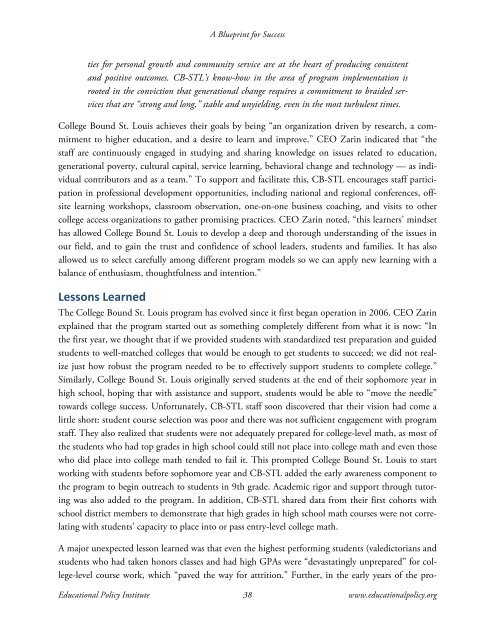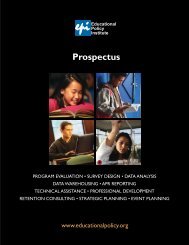A BluePrint for Success: Case Studies of Successful - Educational ...
A BluePrint for Success: Case Studies of Successful - Educational ...
A BluePrint for Success: Case Studies of Successful - Educational ...
You also want an ePaper? Increase the reach of your titles
YUMPU automatically turns print PDFs into web optimized ePapers that Google loves.
A Blueprint <strong>for</strong> <strong>Success</strong><br />
ties <strong>for</strong> personal growth and community service are at the heart <strong>of</strong> producing consistent<br />
and positive outcomes. CB-STL’s know-how in the area <strong>of</strong> program implementation is<br />
rooted in the conviction that generational change requires a commitment to braided services<br />
that are “strong and long,” stable and unyielding, even in the most turbulent times.<br />
College Bound St. Louis achieves their goals by being “an organization driven by research, a commitment<br />
to higher education, and a desire to learn and improve.” CEO Zarin indicated that “the<br />
staff are continuously engaged in studying and sharing knowledge on issues related to education,<br />
generational poverty, cultural capital, service learning, behavioral change and technology — as individual<br />
contributors and as a team.” To support and facilitate this, CB-STL encourages staff participation<br />
in pr<strong>of</strong>essional development opportunities, including national and regional conferences, <strong>of</strong>fsite<br />
learning workshops, classroom observation, one-on-one business coaching, and visits to other<br />
college access organizations to gather promising practices. CEO Zarin noted, “this learners’ mindset<br />
has allowed College Bound St. Louis to develop a deep and thorough understanding <strong>of</strong> the issues in<br />
our field, and to gain the trust and confidence <strong>of</strong> school leaders, students and families. It has also<br />
allowed us to select carefully among different program models so we can apply new learning with a<br />
balance <strong>of</strong> enthusiasm, thoughtfulness and intention.”<br />
Lessons Learned<br />
The College Bound St. Louis program has evolved since it first began operation in 2006. CEO Zarin<br />
explained that the program started out as something completely different from what it is now: “In<br />
the first year, we thought that if we provided students with standardized test preparation and guided<br />
students to well-matched colleges that would be enough to get students to succeed; we did not realize<br />
just how robust the program needed to be to effectively support students to complete college.”<br />
Similarly, College Bound St. Louis originally served students at the end <strong>of</strong> their sophomore year in<br />
high school, hoping that with assistance and support, students would be able to “move the needle”<br />
towards college success. Un<strong>for</strong>tunately, CB-STL staff soon discovered that their vision had come a<br />
little short: student course selection was poor and there was not sufficient engagement with program<br />
staff. They also realized that students were not adequately prepared <strong>for</strong> college-level math, as most <strong>of</strong><br />
the students who had top grades in high school could still not place into college math and even those<br />
who did place into college math tended to fail it. This prompted College Bound St. Louis to start<br />
working with students be<strong>for</strong>e sophomore year and CB-STL added the early awareness component to<br />
the program to begin outreach to students in 9th grade. Academic rigor and support through tutoring<br />
was also added to the program. In addition, CB-STL shared data from their first cohorts with<br />
school district members to demonstrate that high grades in high school math courses were not correlating<br />
with students’ capacity to place into or pass entry-level college math.<br />
A major unexpected lesson learned was that even the highest per<strong>for</strong>ming students (valedictorians and<br />
students who had taken honors classes and had high GPAs were “devastatingly unprepared” <strong>for</strong> college-level<br />
course work, which “paved the way <strong>for</strong> attrition.” Further, in the early years <strong>of</strong> the pro-<br />
<strong>Educational</strong> Policy Institute 38 www.educationalpolicy.org




